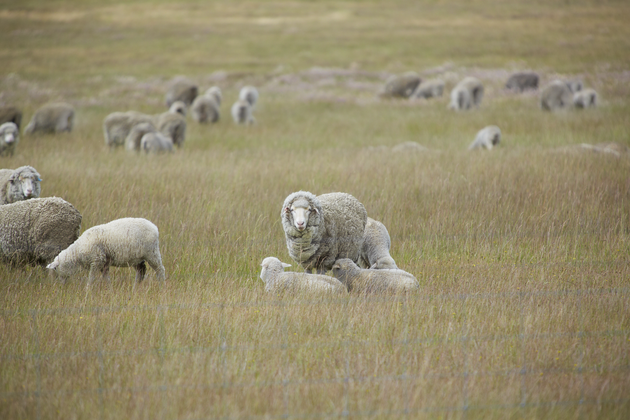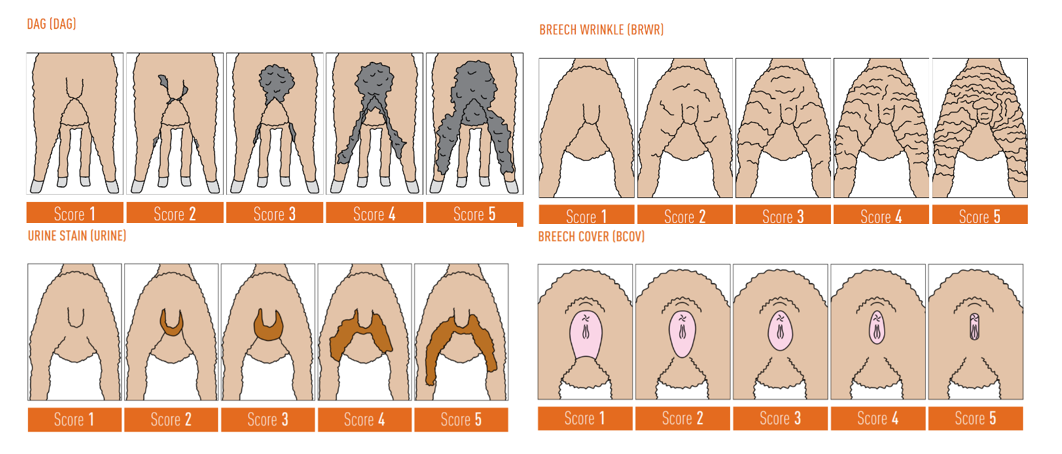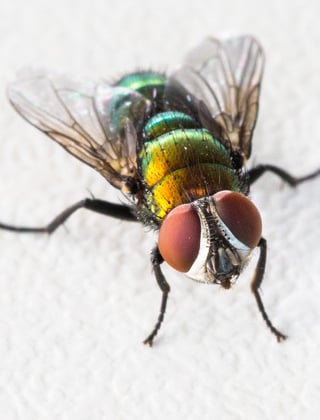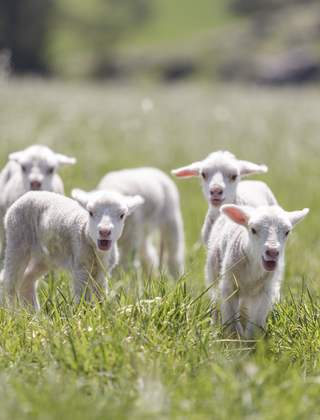Breeding and Selection for Flystrike Resistance

Breeding for more flystrike resistant sheep plays a critical role in controlling flystrike in non-mulesed flocks as well as reducing the risk of flystrike in mulesed sheep.
Over 80% of flystrike occurs in the breech area of the sheep (breech flystrike). The AWI Breeding for Breech Flystrike Resistance Program identified that the most important traits in determining the risk of flystrike are:
- Breech Wrinkle
- Dags
- Urine Stain
Followed by:
- Breech Cover
- Wool Colour
For woolgrowers who are working to phase out mulesing, the goal is to maintain or improve productivity outcomes, whilst breeding a flock that has enhanced resistance to breech flystrike and can be managed effectively, without the need for mulesing or for a high reliance on chemical control.
Sheep genetic research results indicate breeding for enhanced flystrike resistance can be successful, but in many cases will take a considerable amount of time to achieve, particularly for super fine and fine wool sheep and sheep in high dag environments. A range of strategies can be used to breed for flystrike resistance to suit sheep breed, wool type and environment and individual woolgrower breeding strategies must also integrate objectives for other health and welfare traits such as worm resistance, conformation and reproductive performance. Therefore, there is no one-size-fits-all sheep breeding program and breeding strategies need to be customised to the individual farm, guided by key principles identified from AWI’s investment to date in breeding for breech flystrike resistance.
For recent articles on Breeding for breech Strike resistance, click here.
How long will BREEDING FOR BREECH FLYSTRIKE take?
The length of time required to breed sheep that no longer require mulesing not only depends on how intensive the breeding program is, but also on how susceptible the sheep flock is to breech flystrike at the start of the breeding program and the severity of environmental conditions favourable to flystrike likely on the farm. For example, sheep types with high wrinkle scores and / or high dag scores will take considerably longer to reduce susceptibility to breech flystrike to a point where mulesing could be stopped.
A project to model the rate of genetic gain in breeding for breech flystrike resistance, using the data from the AWI Breeding for Breech Flystrike Resistance Program, concluded that:
- For ram breeding flocks that do not import breeding stock, meaningful reductions in flystrike incidence to a sufficient level to reduce reliance on mulesing, or to cease it, are possible over in a fully pedigreed and recorded flock in a 10 to 15-year period, whilst retaining competitive levels of genetic gains for other important health and welfare and productivity traits, by using appropriately constructed selection indexes.
- For commercial flocks, selection and culling strategies such as buying high accuracy elite rams, culling heavily on breech straits and possibly changing the ram source need to be seriously considered to reach the required scores to reduce flystrike incidence for breech traits inside 12-15 years.
- Both ram breeders and commercial producers with superfine sheep are currently more limited in making significant reductions in breech traits, particularly for breech wrinkle, as little genetic gains in breech traits are being achieved within that sheep type relative to fine/medium and dual-purpose sheep types.
Breeding and selection tools
A number of tools are available to support woolgrowers looking to move away from mulesing by breeding for breech flystrike resistance, including visual scores for breech flystrike indicator traits and Australian Sheep Breeding Values (ASBVs).
The FlyBoss Flystrike Risk Simulator is a comprehensive program that allows woolgrowers to compare two different management systems. The program uses the property’s local weather conditions to estimate the risk of flystrike, and woolgrowers can then make adjustments for:
- Management options such as shearing and crutching
- Breech modification procedures
- Chemical preventive treatments including optimising the timing of treatments
- Effect of breeding for reduced breech flystrike.
Visual Scores
Visual scores for important phenotype traits of sheep, including the breech flystrike indicator traits, have been developed to:
- Provide the Australian sheep industry with a standardised set of visual assessment scores for the consistent description of important phenotypic traits of all breeds of sheep;
- Provide a quick and simple scoring system to help sheep classers and breeders select sheep on visually-assessed traits to accelerate genetic gain;
- Enable sheep breeders and classers to record and submit visual score data and genetic information to Sheep Genetics to progress development of across-flock Australian Sheep Breeding Values* (ASBVs) for visually-assessed traits; and
- Enable researchers to estimate the heritability of visually-assessed sheep traits, and to measure their relationships, if any, on important production traits such as fleece weight, fibre diameter, growth rate and body weight.
The visual scores for the key flystrike indictor traits are presented in Figure 1. Information on these, and others, are available in the AWI/MLA Visual Sheep Score Guide (AWI/MLA Visual Sheep Score Guide 2019).

Figure 1. Visual scores for Dag, Breech Wrinkle, Urine Stain and Breech Cover
The lower the score the lower the risk, and in most locations across Australia the following are the key visual score targets woolgrowers are encouraged to aim for, to reduce the risk of breech strike to levels where sheep may be considered naturally resistant without increasing reliance on chemicals:
- Dags - score 2 and less,
- Breech Wrinkle - score 2 and less,
- Urine Stain – score 2 and less, and
- Breech Cover - score 3 and less.
A dag score 4 animal can be up to seven times more susceptible to breech strike than a dag score 1 animal in the same flock.
- Download a copy of the Visual Sheep Scores Guide - Producer Version
- Download a copy of the Visual Sheep Scores Guide - Researcher Version
- Beyond the Bale Article - Visual Sheep Scores - new version now available, June 2020
More information on Breeding and Selection
- The latest in research reports, publications and industry news on breeding and selection for flystrike resistance
- Beyond the Bale Article - Breeding Naturally Breech Strike Resistant Merinos - Part 1, June 2020
- Beyond the Bale Article - Breeding Naturally Breech Strike Resistant Merinos - Part 2, Sept 2020
















